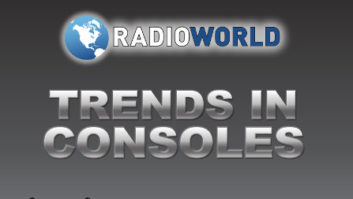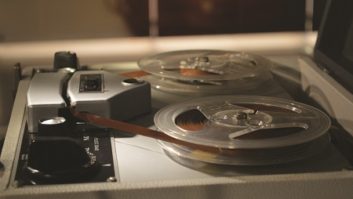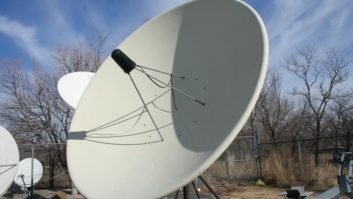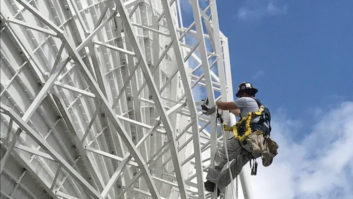Expanded Band Stations On-AirAlthough the FCC issued 65 CPs for the expanded AM band, some licensees let them expire and did not build new facilities, accounting for the 56 entries on this list.
WNRP Gulf Breeze, FL 1620 ADX Communications of Escambia
KSMH West Sacramento, CA 1620 IHR Educational Broadcasting
KBLI Blackfoot, ID 1620 Bonneville Holding Co.
WHLY South Bend, IN 1620 Artistic Media Partners
KOZN Bellevue, NE 1620 Waittcorp Investments
NEW Toms River, NJ 1620 Knox Broadcasting
WTAW College Station, TX 1620 Bryan Broadcasting
WDHP Frederiksted, VI 1620 Reef Broadcasting
KYIZ Renton, WA 1620 KRIZ Broadcasting
WRDW Augusta, GA 1630 WCHZ License
KCJJ Iowa City, IA 1630 River City Radio
KKGM Fort Worth, TX 1630 Mortenson Broadcasting Co. of Texas
KRND Fox Farm, WY 1630 La Familia Broadcasting
KDIA Vallejo, CA 1640 Baybridge Communications
WTNI Biloxi, MS 1640 Monterey Licenses
KFXY Enid, OK 1640 Chisholm Trail Broadcasting
KDZR Lake Oswego, OR 1640 Radio Disney Group
KBJA Sandy, UT 1640 United Broadcasting
WKSH Sussex, WI 1640 Radio Disney Group
KWHN Fort Smith, AR 1650 Capstar TX Limited Partnership
KFOX Torrance, CA 1650 Chagal Communications
KBJD Denver, CO 1650 Salem Media of Colorado
KCNZ Cedar Falls, IA 1650 Fife Communications Co.
KHRO El Paso, TX 1650 Entravision Holdings
WHKT Portsmouth, VA 1650 Radio Disney Group
KTIQ Merced, CA 1660 Mapleton Communications
WCNZ Marco Island, FL 1660 Starboard Media Foundation
KXTR Kansas City, KS 1660 Entercom Kansas City License
WQSN Kalamazoo, MI 1660 Fairfield Broadcasting
WFNA Charlotte, NC 1660 Infinity Radio Holdings
KQWB West Fargo, ND 1660 Monterey Licenses
WWRU Jersey City, NJ 1660 Multicultural Radio Broadcasting Licensee
WGIT Canovanas, PR 1660 International Broadcasting
KRZI Waco, TX 1660 Simmons-Austin, LS
KXOL Brigham City, UT 1660 Simmons-Austin, LS
KHPY Moreno Valley, CA 1670 Delbert L. Van Voorhis
KNRO Redding, CA 1670 Regent Licensee of Redding
WMWR Dry Branch, GA 1670 AMFM Radio Licenses
WTDY Madison, WI 1670 Mid-West Management
KAVT Fresno, CA 1680 Rak Communications
WLAA Winter Garden, FL 1680 Rama Communications
KRJO Monroe, LA 1680 Holladay Broadcasting of Louisiana
WDSS Ada, MI 1680 Goodrich Radio
WTTM Princeton, NJ 1680 Multicultural Radio Broadcasting Licensee
KTFH Seattle, WA 1680 Inspiration Media
KFSG Roseville, CA 1690 Way Broadcasting Licensee
KDDZ Arvada, CO 1690 Radio Disney Group
WWAA Avondale Estates, GA 1690 Intermart Broadcasting of Georgia
WRLL Berwyn, IL 1690 CC Licenses
WPTX Lexington Park, MD 1690 Somar Communications
NEW Charlotte Amalie, VI 1690 Three Angels Corp.
WEUP Huntsville, AL 1700 Hundley Batts, Sr. & Virginia Caples
WJCC Miami Springs, FL 1700 Multicultural Radio Broadcasting Licensee
KBGG Des Moines, IA 1700 Citadel Broadcasting
KKLF Richardson, TX 1700 KRBE Lico
KVNS Brownsville, TX 1700 Clear Channel
Data provided by the FCCWASHINGTON It’s been nearly 20 years since the FCC began proceedings to expand the AM band with hopes of easing interference among existing stations, and the results appear close to meeting the commission’s original goals, according to industry experts.
This year is the deadline for most stations operating on the expanded band to decide whether to stay there and give up their original frequencies, or give up their expanded-band slot and remain on their old frequencies.
The majority of stations authorized to move to the AM expanded band have done so and are now operating with new and improved transmission facilities, a source close to the commission said. At least several expanded-band stations say their improved signals have resulted in additional revenue for them despite their location higher on the AM dial.
Originally, 710 radio stations expressed interest in moving to the expanded AM band. The FCC ruled 88 stations were eligible to apply for construction permits in 1997 after the commission released its third and final allotment plan following several appeals. Of the original 88 stations, only 66 elected to file construction permit applications, with the FCC issuing 65 CPs.
Now, 56 stations are operating in the expanded AM band (see chart, page X). The remaining nine stations allowed their CPs to expire without construction or turning in their expanded-band license.
The original 88 were selected through a complex computer program that “ranked high interference” stations and slotted them in open frequencies in the expanded band. A 1999 order from the FCC extended certain construction permits for those stations on the expanded band.
Dual operation
The FCC allowed migrating stations to operate on dual frequencies for five years. Many of the migrators had until 2005 or ’06 to decide which frequency to keep. The agency’s preference is for them to continue in 1605-1705 kHz to help relieve interference.
“We expect most will keep their new frequencies. In most cases, the facilities are superior at 10 kW and 1 kW night non-directional. However, several have already chosen for a variety of reasons to keep their existing frequency,” a commission source said.
Not all broadcasters were convinced a move to the expanded band would have proved beneficial. VerStandig Broadcasting received a CP in 1997 to move WSVA(AM), licensed to Harrisonburg, Va., from 550 kHz to 1700 kHz. However, the owner let the CP expire without building new facilities.
“We have a very nice-billing station with nice ratings along the Shenandoah Valley. After examining the move further, we decided it would not be economical to make the transition,” said John VerStandig, president of the company.
“This signal at 1700 kHz would not have been any better; and then you have had radios out there unable to receive the station.”
WSVA is 5 kW nondirectional during the day and 1 kW directional at night. The expanded-band frequency would have been 10 kW non-directional daytime and 1 kW non-directional nighttime, VerStandig said.
He said he applied for the expanded-band license originally with the thought that “maybe something in the world would change or maybe the FCC would decide to let broadcasters keep both frequencies, ” which never happened.
“As our deadline to act on the CP approached we just decided to wave off the move. I’m satisfied it was the right decision.”
Some broadcasters who made the move say they suffer little interference in the expanded band; this allows them to better serve their communities and generate more revenue.
“It’s been an excellent move for us,” said Steve Soboroff, owner of KCJJ(AM) in Iowa City, Iowa. “There are an extremely small number of radios out there that can’t get us anymore. Just maybe a few old car radios, but I’ve yet to find a radio that doesn’t have the expanded band.”
KCJJ, originally at 1560 kHz, began simulcasting in 1998 on the expanded band at 1630 kHz and did so for several years before opting to move exclusively to the expanded band.
“We had a directional array at 1560 kHz that was awful. We built new facilities and a new tower site. There is so little interference around 1630 that we get response at night from all over the Midwest and the east coast of the United States,” Soboroff said.
KCJJ, which broadcasts at 10 kW daytime and at 1 kW night nondirectional, has seen its billing go up in “good measure” each year since migrating to 1630 kHz, Soboroff said.
“The response from our listeners has always been positive. We now cover from Davenport, to Cedar Rapids and Des Moines. People are now able to hear the darn station,” he said.
Another station that made the jump, KRZI(AM), Waco, Texas, received authorization to move from 1580 to 1660 kHz and added the expanded-band frequency in 2001.
“It’s been extremely beneficial. It’s been extraordinary. We now have a much better signal with a huge footprint across central Texas,” said Bill LeGrand, general manager of KRZI.
Bigger footprint
The station, owned by Simmons Media Group, went from 1,000 watts directional at 1580 kHz to 10 kW daytime and 1 kW night at 1660 kHz. The station is formatted as ESPN Radio and is the anchor station for Baylor University athletics, LeGrand said.
Because the group’s five-year window to keep both frequencies expires this year, it will be forced to sign off from 1580 kHz this summer; that frequency is now KQRL and simulcasts the country music format of the cluster’s lone FM station.
“We have a sunset clause on 1580 and we are not optimistic that we’ll be able to keep it,” said LeGrand.
“The bigger signal on 1660 certainly adds credibility to the station. People can tune in without the static and interference. With audio processing and all of the other new technological benefits now the station has come along way,” LeGrand said.
Womble Carlyle’s John Garziglia said the efforts of the FCC to reduce congestion in the overcrowded AM band have been successful so far.
“Instead of trying to jam as many stations into the expanded band, (the FCC) slotted them in an engineering way that limited the amount of interference in the expanded portion and will eventually, along the rest of the band, once broadcasters are forced to choose between signals and which to keep.
“Anytime the FCC can create new service and create a better outlet for AM broadcasters it’s a good thing. It was a commendable thing for the FCC to tackle,” Garziglia said.
Garziglia, who represented several broadcasters that built in the expanded portion of the AM band, said he couldn’t explain why more than 20 AM stations authorized by the FCC to migrate failed to file applications.
“I suspect that they concluded that their present frequencies were better that what they would have had at the top of the band,” Garziglia said.
While the right side of the AM dial doesn’t have good propagation characteristics, 1605-1705 kHz offers other benefits, according to a source close to the commission.
“Broadcasters have found, due to the relative absence of other stations on co-channels and adjacent channels, that their signals go very far. They receive very little or zero interference from others,” the source said.
At some point, the commission expects to revisit the expanded AM band issue since “there are a few holes in the national plan” after not all of the authorized stations elected to file applications to migrate, the source said.
There were 4,758 licensed AM radio stations in the United States as of Dec. 8, 2005, according to the FCC.






